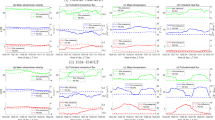Abstract
The main scope of the present work is to investigate the mechanisms underlying the hydroacoustic and hydrodynamic perturbations in a rudder operating in the wake of a free running marine propeller. The study consisted of detailed near-field pressure fluctuation measurements which were acquired on the face and back surfaces of the rudder, at different deflection angles. To this aim, a novel wavelet-filtering procedure was applied to separate and analyze distinctly the acoustic and hydrodynamic components of the recorded near-field pressure signals. The filtering procedure undertakes the separation of intermittent pressure peaks induced by the passage of eddy structures, interpreted as pseudo-sound, from homogenous background fluctuations, interpreted as sound. The use of wavelet in the filtering procedure allows to overcome the limitations of the earlier attempts based on frequency (wave number) band-pass filtering, retrieving the overall frequency content of both the acoustic and the hydrodynamic components and returning them as independent signals in the time domain. Acoustic and hydrodynamic pressure distributions were decomposed harmonically and compared to the corresponding topologies of the vorticity field, derived from earlier LDV measurements performed by Felli and Falchi (Exp Fluids 51(5):1385–1402, 2011). The study highlighted that the acoustic perturbation is mainly correlated with the unsteady load variations of the rudder and to the shear layer fluctuations of the propeller streamtube. Conversely, the dynamics of the propeller tip and hub vortices underlies the hydrodynamic perturbation.













Similar content being viewed by others
References
Anschau P, Mach KP (2009) Stereoscopic PIV measurements of rudder flow and vortex systems in the towing task. ATM 09, Nantes, France
Arndt RE, Long DF, Glauser MN (1997) The proper orthogonal decomposition of pressure fluctuations surrounding a turbulent jet. J Fluid Mech 340:1–33
Biot M, De Lorenzo F (2008) Some notes on the sound reduction index of pax cabins panels on cruise ships. J Acoust Soc Am 123(5):1101–1106
Calcagno G, Di Felice F, Felli M, Pereira F (2005) A stereo-PIV investigation of a propeller’s wake behind a ship model in a large free-surface tunnel. Mar Technol Soc J 39(2):94–102
Carlton JS, Vlasic D (2005) Ship vibration and noise: some topical aspects. 1st international ship noise and vibration conference, London, UK
Cenedese A, Accardo L, Milone R (1988) Phase sampling in the analysis of a propeller wake. Exp Fluids 6:55–60
Chainais P, Abry P, Pinton JF (1999) Intermittency and coherent structures in a swirling flow: a wavelet analysis of joint pressure and velocity measurements. Phys Fluids 2(11):3524–3539
Daubechies I (1992) Ten lectures on wavelets. CBMS-NSF regional conference series in applied mathematics. Society for Industrial and Applied Mathematics. ISBN 978-0898712742
Farge M (1992) Wavelet transforms and their applications to turbulence. Ann Rev Fluid Mech 24:395–457
Farge M, Schneider K, Kevlahan N (1999) Non-Gaussianity and coherent vortex simulation for two-dimensional turbulence using an adaptive orthogonal wavelet basis. Phys Fluids 11:2187–2201
Felli M, Di Felice F (2004) Analysis of the propeller-hull interaction by LDV phase sampling techniques. J Vis 7:77–84
Felli M, Falchi M (2011) Propeller tip and hub vortex dynamics in the interaction with a rudder. Exp Fluids 51(5):1385–1402
Felli M, Di Felice F, Guj G, Camussi R (2006) Analysis of the propeller wake evolution by pressure and velocity phase measurements. Exp Fluids 41:441–451
Felli M, Camussi R, Guj G (2009) Experimental analysis of the flow field around a propeller-rudder configuration. Exp Fluids 46:147–164
Ffowcs-Williams J (1992) Noise source mechanisms. In: Modern Methods in Analytical Acoustics Lecture Notes. Springer, Berlin, pp 313–354
Grizzi S, Camussi R (2012) Wavelet analysis of near-field pressure fluctuations generated by a subsonic jet. J Fluid Mech 544:277–307
Guitton A, Jordan P, Laurendeau E, Delville J (2007) Velocity dependence of the near pressure field of subsonic jets: understanding the associated source mechanisms. AIAA Paper 2007-3661
Hildebrand J (2004) Sources of anthropogenic sound in the marine environment. Scripps Institution of Oceanography, University of California San Diego, USA, California
Howe WL (1960) Similarity of far noise fields of jets. NASA technical report, R-52
Ianniello S, Muscari R, Di Mascio A (2013) Ship underwater noise assessment by the acoustic analogy part II: hydroacoustic analysis of a ship scaled model. J Mar Sci Technol (in press)
Lücke T, Streckwall H (2009) Cavitation research on a very large semi spade rudder. First international symposium on marine propulsors, SMP’09, Trondheim, Norway
Mallat S (1989) A theory for multi resolution signal decomposition: the wavelet representation. Trans IEEE Pattern Anal Mach Intell 11:674–693
Paterson RW, Amiet RK (1976) Acoustic radiation and surface pressure characteristics of an airfoil due to incident turbulence. NASA CR-2733
Ribner HS (1964) The generation of sound by turbulent jets. Adv Appl Mech VIII:103–182
Ruppert-Felsot J, Farge M, Petitjeans P (2009) Wavelet tools to study intermittency: application to vortex bursting. J Fluid Mech 636:427–453
Tinney CE, Jordan P, Delville J, Hall AM, Glauser MN (2007) A time-resolved estimate of the turbulence and sound source mechanisms in a subsonic jet flow. J Turbul 8(7):1–20
Ukeiley LS, Ponton MK (2004) On the near field pressure of a transonic axisymmetric jet. Int J Aeroacoust 3(1):43–66
Acknowledgments
This work was partially supported by the Italian Ministry of Defence in the framework of the research project “PRIAMO” and partially by the Italian Ministry of Education, University and Research in the framework of the research project “RITMARE”, coordinated by CNR.
Author information
Authors and Affiliations
Corresponding author
Rights and permissions
About this article
Cite this article
Felli, M., Grizzi, S. & Falchi, M. A novel approach for the isolation of the sound and pseudo-sound contributions from near-field pressure fluctuation measurements: analysis of the hydroacoustic and hydrodynamic perturbation in a propeller-rudder system. Exp Fluids 55, 1651 (2014). https://doi.org/10.1007/s00348-013-1651-y
Received:
Revised:
Accepted:
Published:
DOI: https://doi.org/10.1007/s00348-013-1651-y




